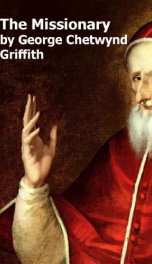Griffith George Chetwynd

George Griffith (1857 – 1906), full name George Chetwyn Griffith-Jones, was a prolific British science fiction writer and noted explorer who wrote during the late Victorian and Edwardian age. Many of his visionary tales appeared in magazines such as Pearson's Magazine and Pearson's Weekly before being published as novels. Griffith was extremely popular in the United Kingdom, though he failed to find similar acclaim in the United States, in part due to his revolutionary and socialist views. A journalist, rather than scientist, by background, what his stories lack in scientific rigour and literary grace they make up for in sheer exuberance of execution. He was the son of a vicar who became a school master in his mid twenties. After writing freelance articles in his spare time, he joined a newspaper for a short spell, then authored a series of secular pamphlets including Ananias, The Atheist's God: For the Attention of Charles Bradlaugh. After the success of Admiral Philip H. Colomb's The Great War of 1892 (itself a version of the more famous The Battle of Dorking), Griffith, then on the staff of Pearson's Magazine, submitted a synopsis for a story entitled The Angel of the Revolution. It remains his best and most famous work. It was the first synthesis of the 'marvel' tale epitomised by Jules Verne, featuring futuristic flying machines, compressed air guns and spectacular areal combat, the 'future war' tales of George Chesney and his imitators and the political utopianism of William Morris's News from Nowhere. He wrote a sequel, serialised as The Syren of the Skies in the magazine and published as a novel under the title of its main character, Olga Romanoff. Although eternally overshadowed by H. G. Wells, Griffith's epic fantasies of romantic anarchists in a future world of war dominated by airship battlefleets and grandiose engineering provided a template for steampunk novels a century before the term was coined. The influence of books such as The Angel of the Revolution and the character of Olga Romanoff on British fantasy writer Michael Moorcock is striking. The concept of revolitonaries imposing "a 'pax aeronautica' over the earth", at the center of Angel of the Revolution, was taken up by Wells many years later, in The Shape of Things to Come. Though a less accomplished writer than Sir Arthur Conan Doyle, Rudyard Kipling or H.G. Wells, his novels were popular in their day and foreshadowed World War I and the Russian Revolutions and the concepts of the air to surface missile and VTOL aircraft . He wrote several tales of adventure set on contemporary earth, while The Outlaws of the Air depicted a future of aerial warfare and the creation of a Pacific island utopia. Sam Moskowitz described him as "undeniably the most popular science fiction writer in England between 1893 and 1895." His science fiction depicted grand and unlikely voyages through our solar system in the spirit of Wells or Jules Verne, though his explorers donned space suits remarkably prescient in their design. Honeymoon in Space saw his newly married adventurers exploring planets in different stages of geological and Darwinian evolution on an educational odyssey which drew heavily on earlier cosmic voyages by Camille Flammarion, Wells, W. S. Lach-Szyrma, and Edgar Fawcett. Its illustrations by Stanley Wood have proved more significant, providing the first depictions of slender, super intelligent aliens with large, bald heads — the archetype of the famous Greys of modern science fiction. As an explorer of the real world he shattered the existing record for voyaging around the world, completing his journey in just 65 days, and helped discover the source of the Amazon river. He died of cirrhosis of the liver, at the age of 48, in 1906. In 2006 Apogee Books released The World Peril of 1910 as part of its series of classic science fiction. In 2008 Apogee released Around the World in 65 Days, an anthology of travel writing. The book collects Griffith's world travels, including one trip around the world done in a record-breaking 65 days. In addition, many of Griffith's other adventures are included. His trip to South America is recounted in "A Railway Beyond the Clouds", "A Ride to the City of the Sun", "A Paradise of Tomorrow", "The Most Majestic Mountain", and "Los Medanos". His travels of North America in "The Snake-Dancers of Arizona" are somehow even more exotic. Griffith claims to have made the first intentional flight across the English Channel in "To France by Air". In "When will the 20th Century Begin?", Griffith discusses the intricacies of time zones, something with which he has quite a lot of practice. In 2009, Leonaur Press released The Angel of the Revolution and Olga Romanoff as a two-volume set entitled Empire of the Air in both hardback and paperback.
do you like this author?
What readers are saying
What do you think? Write your own comment on this book!
write a commentWhat readers are saying
What do you think? Write your own comment on this author!
write a commentBook list

The Angel of the RevolutionA Tale of the Coming Terror
Series:
Unknown
Year:
Unknown
Raiting:
3/5
Show more
add to favoritesadd In favorites

The Mummy and Miss NitocrisA Phantasy of the Fourth Dimension
Series:
Unknown
Year:
Unknown
Raiting:
3.5/5
Show more
add to favoritesadd In favorites

the angel of the revolution a tale of the coming terror
Series:
Unknown
Year:
Unknown
Raiting:
4.5/5
Originally published in 1895. This volume from the Cornell University Library's print collections was scanned on an APT BookScan and converted to JPG 2000 format by Kirtas Technologies. All titles scanned cover to cover and pages may include marks notations and other marginalia present in the original volume.
Show more
add to favoritesadd In favorites
Book list

The Angel of the RevolutionA Tale of the Coming Terror
Series:
Unknown
Year:
Unknown
Raiting:
3/5
Show more
add to favoritesadd In favorites

The Mummy and Miss NitocrisA Phantasy of the Fourth Dimension
Series:
Unknown
Year:
Unknown
Raiting:
3.5/5
Show more
add to favoritesadd In favorites

the angel of the revolution a tale of the coming terror
Series:
Unknown
Year:
Unknown
Raiting:
4.5/5
Originally published in 1895. This volume from the Cornell University Library's print collections was scanned on an APT BookScan and converted to JPG 2000 format by Kirtas Technologies. All titles scanned cover to cover and pages may include marks notations and other marginalia present in the original volume.
Show more
add to favoritesadd In favorites

in an unknown prison land an account of convicts and colonists in new caledonia
Series:
Unknown
Year:
Unknown
Raiting:
4.5/5
Show more
add to favoritesadd In favorites

briton or boer a tale of the fight for africa
Series:
Unknown
Year:
Unknown
Raiting:
4.5/5
This early works is a fascinating Tale of the fight for Africa and still an interesting read today. Preface: In the following romance I have attempted to answer in the form of an essay in prophetic fiction the question which forms the title of the story: 'Is the Briton or the Boer, the Englishman or the Dutch-Afrikander, going to rule South Africa?' My answer, however near to or far from the actual truth it may prove to be, has been thought out and formulated in the country which, as I, with many others of longer and wider experience in South African affairs than I possess, firmly believe will be the scene of the inevitable struggle for absolute and necessary supremacy, and amidst daily converse with the people who will be the chief actors in the drama.......Many of the earliest books, particularly those dating back to the 1900's and before, are now extremely scarce and increasingly expensive. We are republishing these classic works in affordable, high quality, modern editions, using t --This text refers to the Paperback edition.
Show more
add to favoritesadd In favorites

The World Peril of 1910
Series:
Unknown
Year:
Unknown
Raiting:
4/5
"Can there be anything too horrible for the enemies of the Fatherland?" said the Kaiser to the pale Chancellor, with a glint in his eyes which no man in Germany cares to see. "I must ask pardon," replied the Chancellor. "I was astonished, indeed, almost . . . frightened, if your Majesty will allow me to say so -- frightened for the sake of Humanity, if such an awful invention as that becomes realized!" "And what is your opinion, Field Marshal?" asked the Kaiser. "A most excellent invention, your Majesty," said the Field Marshal, "provided that it belongs only to the Fatherland." Long before novels 2010, 2001, or 1984 riveted the world, George Griffith's The World Peril of 1910 thrilled readers with its all-too-credible depiction of the dangers and opportunities ahead.
Show more
add to favoritesadd In favorites

The Romance of Golden Star ...
Series:
Unknown
Year:
Unknown
Raiting:
3/5
Originally published in 1897. This volume from the Cornell University Library's print collections was scanned on an APT BookScan and converted to JPG 2000 format by Kirtas Technologies. All titles scanned cover to cover and pages may include marks notations and other marginalia present in the original volume.
Show more
add to favoritesadd In favorites

The Mummy and Miss Nitocris
Series:
Unknown
Year:
Unknown
Raiting:
2.5/5
A novel by George Griffith (1857 – 1906), a prolific British science fiction writer and noted explorer who wrote during the late Victorian and Edwardian age, focuses on the theme of the fourth dimension.
Show more
add to favoritesadd In favorites

The Missionary
Series:
Unknown
Year:
Unknown
Raiting:
4/5
From Content: "Oh-Eny!" "Well, you needn't be angry, Vane. I kissed you this morning, you know." "That's no reason why you should kiss that chap, too! You're my sweetheart." "Is she? Well, she won't be much longer, because I'm going to have her." "Are you? Shut up, or I'll punch your head." "You can't-and, anyhow, you daren't." Smack! It was a good swinging blow with the open hand across the cheek, and it left a vivid flush behind it on the somewhat sallow skin. "Oh, if you're going to fight I shall go away, and I shan't be friends with either of you." But as the two lads closed, the blue-eyed, golden-haired little beauty only shrank back a little nearer to the after-wheelhouse of the homeward bound P. and O. liner whose deck was the scene of this first act of the tragedy of three lives. A bright flush came into her cheeks, and a new light began to dance in her eyes as the first look of fright died out of them. The breath came and [Pg 2]went more quickly between the half-opened lips with a low sibilant sound. They were pretty, well-cut lips, the upper short and exquisitely curved, and the lower full with the promise of a sensuous maturity. She was only seven, but she was woman enough already to know that these two lads were fighting for her-for the favour of her smiles and the right to her kisses-and so she stayed. She had heard in India how the tigers fought for their mates, and, with the precocity of the Anglo-Indian child, she recognised now the likeness between tigers and men-and boys. She was being fought for. These two lads, albeit they had neither of them seen their eleventh birthday, were using all their strength against each other, hammering each other's faces with their fists, wrestling and writhing, now upstanding and now on the deck at her feet, were not unlike the tigers she had heard her father tell her mother about. She saw the hatred in their eyes, red and swollen by the impact of well-planted blows. She watched the gleam of their teeth between their cut and bleeding lips. They hated each other because they loved her-or, in their boyish way, most firmly believed they did. Their lips were cut and bleeding because she had kissed them. The fascination of the fight grew upon her. The hot young blood began to dance in her veins. She found herself encouraging now one and then the other-always the one who was getting the worst of it for the time being-and when at last the younger and slighter but more wiry and active of them, the one who had caught the other kissing her, took adroit advantage of a roll of the ship and pitched his antagonist backwards so heavily against the wheelhouse that he dropped half-[Pg 3]stunned to the deck, she looked proudly at the panting, bleeding victor, and gasped: "Oh, Vane, I'm so glad you've won. You haven't quite killed him, have you? I suppose the captain would hang you if you did. I'm so sorry it was all about me. I'll never let any one else but you kiss me again. Really I won't. You may kiss me now if you like. Take my handkerchief. Oh, I don't mind the cuts. You did it for me. There! It was brave of you, for he's bigger than you. Poor Reggie, let's help him up. I suppose you'll both have to go to the doctor."
Show more
add to favoritesadd In favorites

A Honeymoon in Space
Series:
Unknown
Year:
Unknown
Raiting:
5/5
A Honeymoon in Space is a science-fiction book that contains romance as well as adventures. The plot of the book describes us a rich man who builds a spaceship, and travels through the Solar system with his friend who is an engineer and with his sweetheart. The author possessing a great sense of humor and a great imagination, describes the other civilizations and the adventures that occur to our characters on a number of planets. Along with the adventures the romantic line goes further and the main characters fall in love slowly. The book is quite easy to read and understand. It is recommended for all readers interested in the early science-fiction.
Show more
add to favoritesadd In favorites
Show more
What readers are saying
What do you think? Write your own comment on this author!
write a commentif you like Griffith George Chetwynd try:
readers also enjoyed
What readers are saying
What do you think? Write your own comment on this author!
write a commentGenre
if you like Griffith George Chetwynd try:
readers also enjoyed
Do you want to exchange books? It’s EASY!
Get registered and find other users who want to give their favourite books to good hands!

